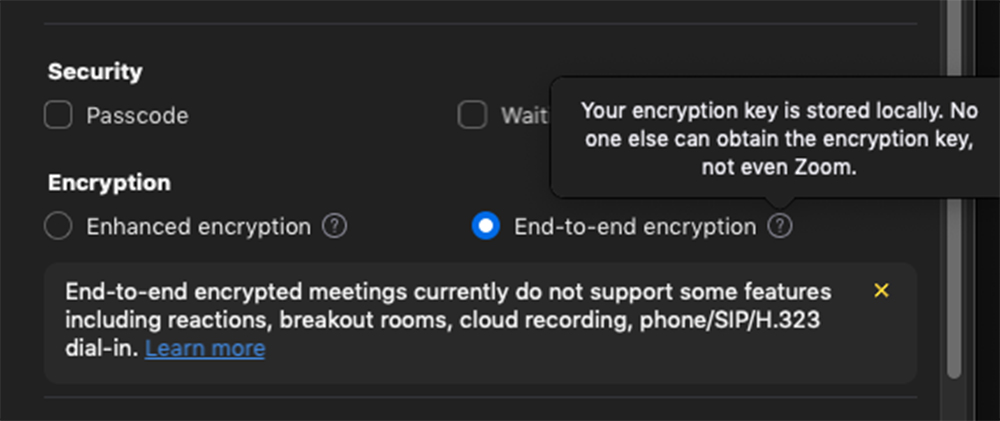10月26日,視頻會(huì)議服務(wù)軟件Zoom為用戶推出了一個(gè)重大新安全升級(jí):端對(duì)端加密,。但這個(gè)額外的防黑客保護(hù)服務(wù)并非是默認(rèn)開啟,,用戶必須通過多個(gè)步驟才能夠開啟這項(xiàng)功能。
Zoom最初在5月宣布了這一額外的安全舉措,,當(dāng)時(shí),,新冠肺炎疫情期間其服務(wù)使用的爆發(fā)式增長(zhǎng)亦導(dǎo)致了安全問題的增加,包括未經(jīng)邀請(qǐng)的陌生人侵入會(huì)議,,也就是Zoom轟炸,。
用戶將不得不認(rèn)真考慮是否開啟端對(duì)端加密服務(wù)。盡管它可以提升安全性,,但也會(huì)屏蔽多個(gè)重要的Zoom功能,。
新加密服務(wù)將面向所有Zoom用戶開放,無論是付費(fèi)還是免費(fèi)用戶,。以下是啟用這一服務(wù)的完整版須知,,包括如何確定自己是否真的需要這種額外的保護(hù)。
什么是端對(duì)端加密,?
Zoom電話會(huì)議默認(rèn)已經(jīng)加密,,意味著視頻和音頻數(shù)據(jù)都已經(jīng)使用算法進(jìn)行過擾碼處理。借助獨(dú)特的秘鑰,,信息的加密方式為,,借助獨(dú)特的秘鑰用其他數(shù)據(jù)取代可讀字符,。
端對(duì)端加密采用了同樣的原理,但它會(huì)改變加密秘鑰的生成和使用方式,。
Zoom當(dāng)前默認(rèn)的加密秘鑰都在Zoom的服務(wù)器上生成,,然后發(fā)放給用戶。此舉加大了頑固黑客截取秘鑰并侵入未受邀請(qǐng)會(huì)議的概率,。在最糟糕的情況下,,黑客可能會(huì)直接從Zoom同時(shí)盜取數(shù)千個(gè)秘鑰,然后在電話會(huì)議期間暗中監(jiān)視Zoom用戶,。
借助端對(duì)端加密技術(shù),,秘鑰將在Zoom用戶的電腦端生成。這意味著包括Zoom本身在內(nèi)的第三方無法獲取加密秘鑰,。Zoom也借此加入了聊天應(yīng)用端對(duì)端加密陣營(yíng),,該陣營(yíng)成員包括Signal、Wickr和WhatsApp,,只不過這一次是用在了視頻領(lǐng)域,。
誰(shuí)需要啟用Zoom端對(duì)端加密?
很多用戶可能并不需要端對(duì)端加密提供的額外保護(hù),。Zoom此前的安全問題大多源于用戶自己的錯(cuò)誤,,例如將會(huì)議向公眾開放。因此,,如果你只是嘗試預(yù)防在線高中歷史課出現(xiàn)令人厭惡的Zoom轟炸行為,,端對(duì)端加密可能就有點(diǎn)牛刀小用了。
但疫情也迫使眾多高度敏感的討論不得不通過線上的形式開展,。例如,,對(duì)于企業(yè)討論、政府會(huì)議和健康咨詢來說,,端對(duì)端加密能夠讓人感到安心,。
當(dāng)然,端對(duì)端加密不好的一面在于,,它亦對(duì)犯罪分子十分有利,。因?yàn)槭褂眠@一技術(shù)的公司無法獲取其用戶的加密秘鑰,也就無法讓執(zhí)法機(jī)構(gòu)接觸到用戶的對(duì)話,。
如何開啟Zoom的端對(duì)端加密
到目前為止,,Zoom用戶需要通過兩個(gè)步驟來開啟端對(duì)端加密。首先,,用戶必須在Zoom賬戶的安全設(shè)置中啟用這一功能,。
截圖如下:

第二,端對(duì)端加密必須由每個(gè)會(huì)議的發(fā)起者激活并管理,。在激活后,,沒有在其賬戶激活端對(duì)端加密的參與者將無法加入會(huì)議,。因此,如果你正在使用端對(duì)端加密,,請(qǐng)確保告知受邀人,,他們自己在加入會(huì)議前也必須在其賬戶端激活這一功能。
Zoom端對(duì)端加密開啟之后無法使用的一些重要功能
讓端對(duì)端加密兼容多方視頻是一個(gè)嚴(yán)峻的技術(shù)挑戰(zhàn),,至少對(duì)于這個(gè)初期版本來說是這樣,因此Zoom不得不有所取舍,。廣泛來說,,Zoom視頻會(huì)議使用的技術(shù)在互動(dòng)、便利性方面有所欠缺,,而且要求發(fā)起方和參與方進(jìn)行更多的設(shè)置和準(zhǔn)備,。
Zoom稱無法啟用的諸多功能包括云端會(huì)議錄制;參會(huì)人員現(xiàn)場(chǎng)表情符號(hào)互動(dòng),;用戶先于發(fā)起方進(jìn)入會(huì)議,;面向外部觀眾播放會(huì)議;現(xiàn)場(chǎng)標(biāo)注,;投票,;一對(duì)一私聊;以及將參與者分成不同的小組,。
然而,,最明顯的禁用功能可能是電話撥入。所有參與端對(duì)端加密電話會(huì)議的人員必須使用Zoom移動(dòng)端或桌面軟件,,并啟用端對(duì)端加密服務(wù),。這一點(diǎn)對(duì)于那些不怎么精通技術(shù)的用戶或者那些喜歡使用電話接入會(huì)議的人來說可能會(huì)成為一個(gè)巨大的障礙。
不過,,其中一些限制可能是臨時(shí)性的,。這周計(jì)劃推出的是“第一階段”內(nèi)容,公司計(jì)劃于明年推出“第二階段”的更新,。我們預(yù)計(jì)后者將包括身份管理的改善,,可能會(huì)讓加入加密會(huì)議變得更便捷,或抵消掉Zoom隱私保護(hù)工具首次迭代所帶來其他一些不便之處,。(財(cái)富中文網(wǎng))
譯者:馮豐
審校:夏林
10月26日,,視頻會(huì)議服務(wù)軟件Zoom為用戶推出了一個(gè)重大新安全升級(jí):端對(duì)端加密。但這個(gè)額外的防黑客保護(hù)服務(wù)并非是默認(rèn)開啟,,用戶必須通過多個(gè)步驟才能夠開啟這項(xiàng)功能,。
Zoom最初在5月宣布了這一額外的安全舉措,當(dāng)時(shí),,新冠肺炎疫情期間其服務(wù)使用的爆發(fā)式增長(zhǎng)亦導(dǎo)致了安全問題的增加,,包括未經(jīng)邀請(qǐng)的陌生人侵入會(huì)議,,也就是Zoom轟炸。
用戶將不得不認(rèn)真考慮是否開啟端對(duì)端加密服務(wù),。盡管它可以提升安全性,,但也會(huì)屏蔽多個(gè)重要的Zoom功能。
新加密服務(wù)將面向所有Zoom用戶開放,,無論是付費(fèi)還是免費(fèi)用戶,。以下是啟用這一服務(wù)的完整版須知,包括如何確定自己是否真的需要這種額外的保護(hù),。
什么是端對(duì)端加密,?
Zoom電話會(huì)議默認(rèn)已經(jīng)加密,意味著視頻和音頻數(shù)據(jù)都已經(jīng)使用算法進(jìn)行過擾碼處理,。借助獨(dú)特的秘鑰,,信息的加密方式為,借助獨(dú)特的秘鑰用其他數(shù)據(jù)取代可讀字符,。
端對(duì)端加密采用了同樣的原理,,但它會(huì)改變加密秘鑰的生成和使用方式。
Zoom當(dāng)前默認(rèn)的加密秘鑰都在Zoom的服務(wù)器上生成,,然后發(fā)放給用戶,。此舉加大了頑固黑客截取秘鑰并侵入未受邀請(qǐng)會(huì)議的概率。在最糟糕的情況下,,黑客可能會(huì)直接從Zoom同時(shí)盜取數(shù)千個(gè)秘鑰,,然后在電話會(huì)議期間暗中監(jiān)視Zoom用戶。
借助端對(duì)端加密技術(shù),,秘鑰將在Zoom用戶的電腦端生成,。這意味著包括Zoom本身在內(nèi)的第三方無法獲取加密秘鑰。Zoom也借此加入了聊天應(yīng)用端對(duì)端加密陣營(yíng),,該陣營(yíng)成員包括Signal,、Wickr和WhatsApp,只不過這一次是用在了視頻領(lǐng)域,。
誰(shuí)需要啟用Zoom端對(duì)端加密,?
很多用戶可能并不需要端對(duì)端加密提供的額外保護(hù)。Zoom此前的安全問題大多源于用戶自己的錯(cuò)誤,,例如將會(huì)議向公眾開放,。因此,如果你只是嘗試預(yù)防在線高中歷史課出現(xiàn)令人厭惡的Zoom轟炸行為,,端對(duì)端加密可能就有點(diǎn)牛刀小用了,。
但疫情也迫使眾多高度敏感的討論不得不通過線上的形式開展。例如,,對(duì)于企業(yè)討論,、政府會(huì)議和健康咨詢來說,,端對(duì)端加密能夠讓人感到安心。
當(dāng)然,,端對(duì)端加密不好的一面在于,,它亦對(duì)犯罪分子十分有利。因?yàn)槭褂眠@一技術(shù)的公司無法獲取其用戶的加密秘鑰,,也就無法讓執(zhí)法機(jī)構(gòu)接觸到用戶的對(duì)話,。
如何開啟Zoom的端對(duì)端加密
到目前為止,Zoom用戶需要通過兩個(gè)步驟來開啟端對(duì)端加密,。首先,,用戶必須在Zoom賬戶的安全設(shè)置中啟用這一功能。
截圖如下:
第二,,端對(duì)端加密必須由每個(gè)會(huì)議的發(fā)起者激活并管理。在激活后,,沒有在其賬戶激活端對(duì)端加密的參與者將無法加入會(huì)議,。因此,如果你正在使用端對(duì)端加密,,請(qǐng)確保告知受邀人,,他們自己在加入會(huì)議前也必須在其賬戶端激活這一功能。
Zoom端對(duì)端加密開啟之后無法使用的一些重要功能
讓端對(duì)端加密兼容多方視頻是一個(gè)嚴(yán)峻的技術(shù)挑戰(zhàn),,至少對(duì)于這個(gè)初期版本來說是這樣,,因此Zoom不得不有所取舍。廣泛來說,,Zoom視頻會(huì)議使用的技術(shù)在互動(dòng),、便利性方面有所欠缺,而且要求發(fā)起方和參與方進(jìn)行更多的設(shè)置和準(zhǔn)備,。
Zoom稱無法啟用的諸多功能包括云端會(huì)議錄制,;參會(huì)人員現(xiàn)場(chǎng)表情符號(hào)互動(dòng);用戶先于發(fā)起方進(jìn)入會(huì)議,;面向外部觀眾播放會(huì)議,;現(xiàn)場(chǎng)標(biāo)注;投票,;一對(duì)一私聊,;以及將參與者分成不同的小組。
然而,,最明顯的禁用功能可能是電話撥入,。所有參與端對(duì)端加密電話會(huì)議的人員必須使用Zoom移動(dòng)端或桌面軟件,并啟用端對(duì)端加密服務(wù),。這一點(diǎn)對(duì)于那些不怎么精通技術(shù)的用戶或者那些喜歡使用電話接入會(huì)議的人來說可能會(huì)成為一個(gè)巨大的障礙,。
不過,,其中一些限制可能是臨時(shí)性的。這周計(jì)劃推出的是“第一階段”內(nèi)容,,公司計(jì)劃于明年推出“第二階段”的更新,。我們預(yù)計(jì)后者將包括身份管理的改善,可能會(huì)讓加入加密會(huì)議變得更便捷,,或抵消掉Zoom隱私保護(hù)工具首次迭代所帶來其他一些不便之處,。(財(cái)富中文網(wǎng))
譯者:馮豐
審校:夏林
Videoconferencing service Zoom rolled out a major new security upgrade for users on October 26: end-to-end encryption. But the extra protection against hackers won’t be offered by default, meaning users will have to take several steps to turn it on.
Zoom initially announced the extra security in May, when exploding use of its service during the coronavirus pandemic led to a rise in security problems, including strangers joining calls uninvited, known as Zoombombing.
Users will have to give some serious thought to whether to enable end-to-end encryption. Although it increases security, it disables a number of key Zoom features.
The new encryption will be available to all Zoom users, whether they have paid or free accounts. Here’s everything to know, including how to decide whether you even need the extra protection.
What is end-to-end encryption?
Zoom calls are already encrypted by default, meaning that video and audio data are scrambled using an algorithm. Information is encoded by replacing readable characters with other data, using a unique key.
End-to-end encryption works on the same principle, but it changes how encryption keys are created and used.
Keys for Zoom’s current default encryption are created on Zoom’s servers, then distributed to users. This increases the chances that a determined hacker could intercept a key and access a meeting uninvited. In a worst-case scenario, hackers could steal thousands of keys at the same time directly from Zoom and then spy on Zoom’s users during their calls.
With end-to-end encryption, keys will instead be generated on the computers of Zoom users. This should mean third parties, including Zoom itself, can’t get their hands on encryption keys. This brings Zoom in line with end-to-end encrypted chat apps like Signal, Wickr, and WhatsApp—except in this case, it applies to video.
Who needs end-to-end encryption for Zoom calls?
Many users probably don’t need the extra protection provided by end-to-end encryption. Zoom’s previous security problems were mostly the result of user error, such as making meetings publicly accessible. So if you’re just trying to deter nuisance Zoombombings of an online high school history class, end-to-end encryption is probably overkill.
But the pandemic has also pushed many highly sensitive conversations online. For corporate discussions, government meetings, and health consultations, for instance, end-to-end encryption can provide peace of mind.
Of course, on the flip side, end-to-end encryption is also useful for criminals.Because companies using it lack access to their users’ encryption key, the companies are incapable of giving law enforcement access to users’ communications.
How to turn on end-to-end encryption in Zoom
For now, Zoom users will need to go through a two-part process to get end-to-end encryption. First, users must enable it in the security settings of their Zoom accounts.
Here’s what that looks like:
Secondly, end-to-end encryption must be activated and managed by each meeting’s host. If it’s activated, attendees who don’t have end-to-end encryption activated on their own accounts will be unable to join meetings. So if you’re using end-to-end encryption, be sure to let invitees know they must activate the feature on their own account before joining your meeting.
Some key Zoom features won’t work with end-to-end encryption
Making end-to-end encryption work with multiparty video is a serious technical challenge, and at least with this early version, Zoom had to make some tradeoffs. Broadly speaking, Zoom calls using the technology will be less interactive, less convenient, and require more setup and preparation by both hosts and attendees.
Among the features Zoom says won’t work are recording meetings to the cloud; live emoji reactions from meeting participants; users’ ability to join a call before the host; streaming a meeting to outside viewers; live transcription; polling; one-on-one private chat; and splitting participants into breakout rooms.
But perhaps the most notable missing feature will be telephone dial-in. All participants in end-to-end encrypted calls must use Zoom mobile or desktop software and have end-to-end encryption enabled. That could be a significant hurdle for less tech-savvy users, or others who prefer using their phones to dial in to meetings.
However, some of these limitations may be temporary. This week’s planned rollout is “phase 1,” with a “phase 2” update planned for next year. It’s expected to include improved identity management, which might make joining encrypted calls easier or offset some of the other inconveniences of Zoom’s first iteration of total privacy.






